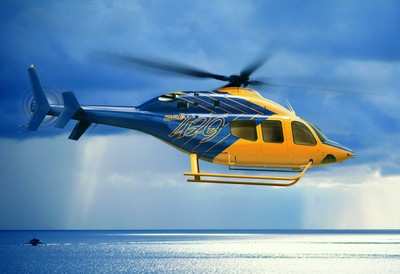Wed, Sep 08, 2010
System Approved For 9 Degree LPV Approaches At 45 knots
The FAA has certified Bell Helicopter's precision Wide Area
Augmentation System (WAAS) enabled glide path capability on the
Bell 429. The aircraft is the only helicopter available with
technology certified for 9 degree localizer precision with vertical
guidance (LPV) approaches at a minimum velocity for instrument
procedures (Vmini) of 45 knots. Such a low minimum velocity
allows for the Bell 429 to fly LPV procedures in steep approach
conditions.

Using a modernized cockpit layout and navigation solutions the
Bell WAAS capability, as demonstrated on the Bell 429, increases
helicopter safety, mission efficiency and environmental
sensitivity, while reducing precision approach limitations and
associated operational costs. Many flights are grounded annually
due to poor weather conditions, the WAAS capability allows for
point-in-space approaches as low as 250 foot visibility.
Bell's 429 WAAS implementation changes the helicopter operating
environment, allowing for the creation of a safer rotorcraft IFR
system, providing a platform to put those capabilities to use and
allowing for precision approaches in low altitude, urban areas.
Designed, developed, implemented and tested by a government
industry partnership, the continuing airspace infrastructure
project will facilitate the creation of public use rotorcraft
solutions and provide a solid framework for additional next
generation national airspace developments. Along with Bell, the
team includes the Federal Aviation FAA's Global Navigation
Satellite System (GNSS) Program Office, the FAA Flight Standards
Organization, Hickok and Associates, Air Methods Corporation, and
the Mercy Medical Team.

"It is because of this collaboration we are able to provide the
helicopter industry and our customers with innovative solutions
that exceed their mission requirements," said Nick Lappos, Bell
Helicopter chief technology officer. "It is only fitting that this
capability be available exclusively on the world's most advanced
light twin helicopter, the 429."
This technology is available immediately on all new Bell 429s
delivered out of the Bell Helicopter Mirabel, Canada facility. Bell
Helicopter is exploring the use of this technology on additional
Bell aircraft. "WAAS technologies, when combined with the 429,
provide all operators engaged in IFR operations a vehicle to
complete missions that were unthinkable in the past. This total
aircraft solution will increase the number of missions that are
flown and ultimately save more lives," said Roberts.
More News
Circle To Runway (Runway Number) Used by ATC to inform the pilot that he/she must circle to land because the runway in use is other than the runway aligned with the instrument appr>[...]
Aero Linx: National Aviation Safety Foundation (NASF) The National Aviation Safety Foundation is a support group whose objective is to enhance aviation safety through educational p>[...]
At Altitude Of About 250-300 Ft Agl, The Airplane Experienced A Total Loss Of Engine Power On November 6, 2024, at 1600 central standard time, a De Havilland DHC-1, N420TD, was inv>[...]
From 2009 (YouTube Edition): Three Hour Flight Was 'Flawless' -- At Least, Until Mother Nature Intervened For anyone who loves the aviation business, this was a VERY good day. Afte>[...]
Also: AMA Names Tyler Dobbs, More Falcon 9 Ops, Firefly Launch Unsuccessful, Autonomous F-16s The Air Force has begun ground testing a future uncrewed jet design in a milestone tow>[...]
 ANN's Daily Aero-Term (05.05.25): Circle To Runway (Runway Number)
ANN's Daily Aero-Term (05.05.25): Circle To Runway (Runway Number) ANN's Daily Aero-Linx (05.05.25)
ANN's Daily Aero-Linx (05.05.25) NTSB Prelim: De Havilland DHC-1
NTSB Prelim: De Havilland DHC-1 Classic Aero-TV: The Boeing Dreamliner -- Historic First Flight Coverage
Classic Aero-TV: The Boeing Dreamliner -- Historic First Flight Coverage Airborne-NextGen 05.06.25: AF Uncrewed Fighters, Drones v Planes, Joby Crew Test
Airborne-NextGen 05.06.25: AF Uncrewed Fighters, Drones v Planes, Joby Crew Test




